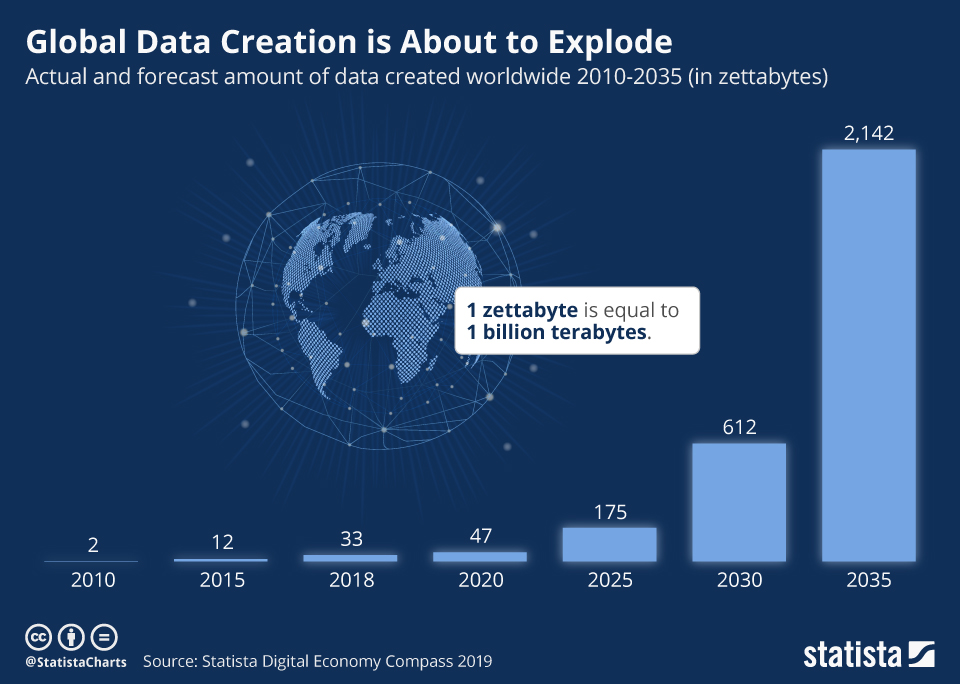From basic online interactions and business processes to AI technologies, which not only utilise data as a source of raw material but also create new sets of information, the amount of data we produce every single day is mind-blowing.
Here is some supporting evidence: 90% of the data currently existing in the world has been created over the last 2 years. This might be worth re-reading! Why? Because fully grasping the complexity of this information along with its long-term impact can be quite difficult.
To make things a little easier, we’ve compiled some interesting stats that provide a more comprehensive and clear picture. At the end of this blog post, we also reveal a solution to many data storage and management challenges that most businesses face nowadays.
The Number of Internet Users in the World Grows at an Annual Rate of 6%
In 2023, there were 5.3 billion active Internet users worldwide, of whom nearly 94% were social media users. Although the digital population used to grow by 3.7% a year until a few years ago, the number of internet users has increased at an annual rate of 6% over the past few years. Higher numbers of internet users will translate into larger amounts of data generated.
Every Day, We Produce 328.77 Million Terabytes of Data Worldwide
This translates into 120 ZBs generated in just one year. However, the growing popularity of the Internet of Things (IoT) is expected to accelerate the data creation pace.
AS A RESULT…
Data Volumes Are Projected to Reach 2,142 Zettabytes (ZBs) Worldwide by 2035
That means 2,142 billion terabytes (TBs)! According to recent research, the amount of data will continue to increase exponentially.
 You will find more infographics at Statista
You will find more infographics at Statista
AND YET…
80% to 90% of All the Data We Produce Remains Unstructured (and Untapped)!
THE REASONS
- Current networking and storage infrastructure is unable to cope with the increasing volumes and variety of data.
- Hardware failures are responsible for 55% of downtime events, leading to significant data loss; hard drives have a lifespan of only 3 to 5 years and an average fail rate of 1.47%.
- In a recent survey, hardware failure was a common cause of data loss for 20% of respondents, while software failure for 22%.
- In 2023, 72% of companies fell victim to ransomware attacks, which often resulted in significant data loss.
- In 2022, cyber attacks on cloud services increased by 95%.
THE SOLUTION: Decentralised Storage – Filecoin
- It creates multiple copies of the original data and stores them on different nodes across the network; in the case of a cyberattack, power outage, or node (hardware) failure, copies of the original data can be retrieved easily from other nodes.
- It reduces bandwidth usage and is inherently scalable; adding more computing power or storage capacity can be achieved by simply incorporating additional nodes.
- It ensures 99.99% uptime, which means only 0.01% downtime.
CLOUD STORAGE VS. DECENTRALISED STORAGE
| CLOUD STORAGE | DECENTRALISED STORAGE |
| Cloud storage is like a massive off-site warehouse where numerous businesses keep their stuff. It is typically more convenient, cost-effective, and secure than “on-site self-storage units” (e.g. external hard drives). However, “burglars” (hackers) can still break into this “warehouse” (hack into servers) and steal or destroy the collective “belongings”. |
Decentralised storage is like having an off-site network of self-storage units, each holding some of your possessions. An important aspect is that you’ll have full control over who has access to each unit. Since data is duplicated and stored across multiple nodes across the network, no single entity can gain complete access to all of your data. That significantly reduces the risk of data breaches and can even prevent data loss entirely. |
CASE STUDIES
- Starling Lab for Data Integrity: establishing trust in humanity’s most vital information.
- iPollo: increased storage capacity, interoperability, and content persistence.
Data Units Refresher
- Bit (b) – The smallest unit of data in computing represented by a 1 in binary.
- Byte (B) – Equal to 8 bits.
- Kilobyte (KB) – 1,024 Bytes.
- Megabyte (MB) – 1,024 Kilobytes.
- Gigabyte (GB) – 1,024 Megabytes.
- Terabyte (TB) – 1,024 Gigabytes.
- Petabyte (PB) – 1,024 Terabytes.
- Exabyte (EB) – 1,024 Petabytes.
- Zettabyte (ZB) – 1,024 Exabytes.
- Yottabyte (YB) – 1,024 Zettabytes.




